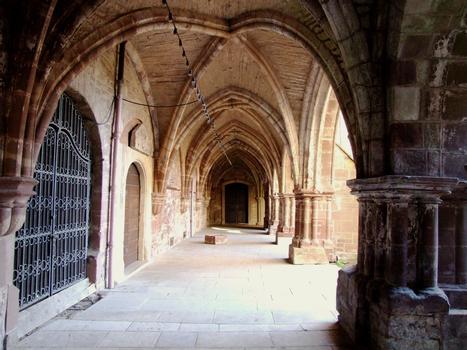General Information
| Other name(s): | Ancienne abbaye Saint-Colomban |
|---|---|
| Status: | in use |
Project Type
| Function / usage: |
original use: Church current use: City or town hall |
|---|
Location
| Location: |
Luxeuil-les-Bains, Haute-Saône (70), Bourgogne-Franche-Comté, France |
|---|---|
| Coordinates: | 47° 48' 59.04" N 6° 22' 53" E |
Technical Information
There currently is no technical data available.
Excerpt from Wikipedia
Luxeuil Abbey (French pronunciation: [lyksœj]), the Abbaye Saint-Pierre et Sain-Paul, was one of the oldest and best-known monasteries in Burgundy, located in what is now the département of Haute-Saône in Franche-Comté, France.
History
Columbanus
It was founded circa 585–590 by the Irish missionary Saint Columbanus. Columbanus and his companions first settled in cells at Annegray, in the commune of Voivre, Haute-Saône. Looking for a more permanent site for his community, Columbanus decided upon the ruins of a well-fortified Gallo-Roman settlement, Luxovium, about eight miles away. The Roman town had been ravaged by Attila in 451, and was now buried in the dense overgrown woodland that had filled the abandoned site over more than a century, but the place still had the advantage of the thermal baths ("constructed with unusual skill", according to Columbanus' early biographer, Jonas of Bobbio) down in the valley, which still give the town its name of Luxeuil-les-Bains. Jonas described it further: "There stone images crowded the nearby woods, which were honoured in the miserable cult and profane former rites in the time of the pagans".
With a grant from an officer of the palace at Childebert's court, an abbey church was built with a sense of triumph within the heathen site and its "spectral haunts".
Under the intellectual and spiritual stimulation of the Irish monks, the abbey at Luxeuil, dedicated to Saint Peter, soon became the most important and flourishing monastery in Gaul. The community was so large that choir followed choir in the chanting of the office, and at Luxeuil the laus perennis imported from Agaunum went on day and night.
Most of the earliest rule that was observed at Luxeuil derived from Celtic monastic traditions, whether or not written down by Columbanus, supplemented increasingly by the more formalized Benedictine Rule that was followed throughout the West, which provided for the abbot's orderly election, his relations with his monks, and the appointment of monastic officials and their delegated powers. In 603, a synod accused Columbanus of keeping Easter by the Celtic date, but his severity and the inflexible rule he had established may have been the true cause of friction with the Burgundian court.
Eustace of Luxeuil
Columbanus was exiled from Luxeuil by Theuderic II of Austrasia and the dowager Queen Brunehaut. He was succeeded as abbot by Saint Eustace of Luxeuil, the head of the monastic school, which under Eustace and his successor Saint Waldebert, established a high reputation. The school and example of Luxeuil contributed significantly to the conversion of the Burgundians. Luxeuil sent out monks to found houses at Bobbio, between Milan and Genoa, where Columbanus himself became abbot, and monasteries at Saint-Valéry and Remiremont. To Luxeuil came such monks as Conon, abbot of Lérins Abbey to prepare for the reform of his monastery, and Saints Wandregisel and Philibert, founders respectively of the abbeys of Fontenelle and Jumièges in Normandy, who spent years in studying the rule observed in monasteries which derived their origin from Luxeuil.
Saracen, Viking and Hungarian raids
About 732, a raiding party of Moors under the skillful general Abdul Rahman Al Ghafiqi, governor of Al-Andalus, penetrating from Arles deep into Burgundy, briefly took possession of Luxeuil and massacred most of the community, including Abbot Mellinus. The few survivors rebuilt the abbey, but both the monastery and the small town that clustered around its walls were devastated by the Vikings in about 825. Later, under the reforming government of the eighteenth abbot, Saint Ansegisus, the Emperor Louis the Pious renewed its charters, restored the church and monastic buildings, and reformed discipline. In 917, it was sacked by the Hungarians.
Modern period
From the 15th century the institution of commendatory abbots encouraged the decline of discipline. The Emperor Charles V curtailed the power of Luxeuil's abbots.
In 1634, however, the commendatory abbots ceased, and Luxeuil was joined to the reformed Congregation of St. Vanne. From the report of the "Commission des Réguliers", drawn up in 1768, the community appears to have been numerous and flourishing, and discipline well kept.
French Revolution
At the French Revolution the monks were dispersed. Most of the abbey's site is built over by the modern town, but the fine Gothic church, built in the 14th century, was not destroyed; neither were the cloisters and conventual buildings, which until the "Association Laws" of 1901 were used as a seminary for the diocese of Besançon, and still remain in existence. The church itself has for many years served as the parish church of Luxeuil-les-Bains.
Text imported from Wikipedia article "Luxeuil Abbey" and modified on July 23, 2019 according to the CC-BY-SA 4.0 International license.
Participants
Currently there is no information available about persons or companies having participated in this project.
Relevant Web Sites
- About this
data sheet - Structure-ID
20018698 - Published on:
27/11/2005 - Last updated on:
29/07/2014








